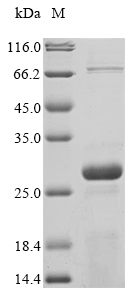Recombinant Yersinia enterocolitica Protein YopB is produced in E. coli and includes an N-terminal 6xHis-tag, which simplifies the purification process. This product represents a partial expression region spanning amino acids 1-165. The protein comes with purity levels above 85%, verified through SDS-PAGE analysis. Intended strictly for research purposes, this recombinant protein lacks endotoxin information.
YopB appears to be a crucial element of the Type III secretion system in Yersinia enterocolitica. It likely plays a central role in moving effector proteins into host cells. The protein seems essential for the bacterium's ability to cause disease, which makes it an attractive target for investigating bacterial infection pathways and possibly developing therapeutic approaches.
Potential Applications
Note: The applications listed below are based on what we know about this protein's biological functions, published research, and experience from experts in the field. However, we haven't fully tested all of these applications ourselves yet. We'd recommend running some preliminary tests first to make sure they work for your specific research goals.
Yersinia enterocolitica YopB is a bacterial effector protein that requires specific membrane association and interaction with other type III secretion system components for its pore-forming activity. The E. coli expression system can produce bacterial proteins, but YopB's function depends on proper insertion into membranes and interaction with YopD. The partial sequence (1-165aa) may not contain all functional domains, and the His-tag could interfere with membrane association. While the protein may be soluble, the probability of correct functional folding and activity is low without the full context of the type III secretion system.
1. Antibody Development and Immunological Studies
This recombinant YopB fragment serves as an excellent immunogen for generating antibodies against the N-terminal region of Yersinia YopB. The partial sequence provides specific epitope coverage, and the His-tag facilitates purification and screening. These antibodies will be valuable for detecting YopB in bacterial cultures or infection studies.
2. ELISA-Based Binding Assays
This protein is well-suited as an antigen for immunoassays to detect anti-YopB antibodies. However, for functional binding studies with host cell proteins, the partial length and potential misfolding make it unreliable.
3. Biochemical Characterization and Stability Studies
This is the essential first step to assess the protein's physical properties. Techniques like circular dichroism can analyze secondary structure, while thermal shift assays evaluate stability. These studies provide critical quality control data about the protein itself, not the native protein.
Final Recommendation & Action Plan
This recombinant YopB fragment is primarily valuable for antibody production and biochemical characterization but requires validation for interaction studies. The immediate priority is Application 3 (Biochemical Characterization) to assess the protein's folding state. Application 1 (Antibody Development) can proceed immediately. Application 2 should be limited to immunoassays only. A partial YopB fragment may not maintain the correct conformation for specific interactions with host proteins or bacterial partners like YopD. The His-tag may cause steric interference. Results would require validation with a full-length protein. For functional studies, a full-length protein in the context of type III secretion system components is recommended.






